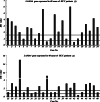LAMA4, highly expressed in human hepatocellular carcinoma from Chinese patients, is a novel marker of tumor invasion and metastasis
- PMID: 18084776
- PMCID: PMC12160715
- DOI: 10.1007/s00432-007-0342-6
LAMA4, highly expressed in human hepatocellular carcinoma from Chinese patients, is a novel marker of tumor invasion and metastasis
Abstract
Purpose: Hepatocellular carcinoma (HCC) is one of the most common malignant tumors in China. Hepatocarcinogenesis is correlated with a series of gene expression alteration. Here, we investigated LAMA4 gene expression in hepatocellular carcinoma on both mRNA and protein levels, expecting to explore the relationship between expressional abundances of LAMA4 and the clinical characteristics of HCC specimens.
Method: Total RNA was extracted from 48 cases of surgically resected HCC specimens and their corresponding peripheral tumor-free liver tissues. After the optimal reverse transcription polymerase chain reaction condition was established, the mRNA levels of LAMA4 in tumor and peripheral tumor-free tissues were examined semi-quantitatively. The relationship between expression levels of LAMA4 and clinical pathological characteristics was further analyzed by two-tailed t-test and chi2 test. We also used anti-LAMA4 antibody to detect the in vivo distribution of LAMA4 protein by tissue immunofluorescence staining in HCC specimens and their peripheral tumor-free tissues.
Results: The expression level of LAMA4 in 48 cases of human hepatocellular carcinoma tissues was significantly higher than that in their corresponding peripheral tumor-free tissues (0.37 +/- 0.25 vs. 0.18 +/- 0.12, P < 0.01). LAMA4 gene was up-regulated in 30 (62.50%) cases of HCC, down regulated in 4 (8.33%) cases, and showed no significant changes in 14 (29.17%) cases. Analysis of relationship between LAMA4 gene expression abundances and clinical characteristics by chi2 test showed that up-regulation of LAMA4 was strongly correlated with tumor invasion (79.31%), incomplete or no envelope (75.00%) and tumor bolt (86.67%). Additionally, tissue immunofluorescence staining against LAMA4 protein detected strong signal only in HCC tissues but not their corresponding peripheral tumor-free liver tissues. To our attention, LAMA4 protein showed specific in vivo distribution along the basement membrane of tumor blood vessels, bringing insights into its potential role in tumor angiogenesis.
Conclusions: LAMA4 is specifically up-regulated on both mRNA and protein levels in hepatocelluar carcinoma. The strong correlation between high expression abundances of LAMA4 with tumor invasion and metastasis, as well as, LAMA4 specific in vivo distribution in tumor basement membrane, indicated LAMA4's potential role in hepatocarcinogenesis and tumor progression. Therefore, we hypothesize that LAMA4 is probably a novel supplementary marker for HCC diagnosis, and might be a molecular target in the future cancer therapy.
Figures





Similar articles
-
The circular RNA ciRS-7 (Cdr1as) acts as a risk factor of hepatic microvascular invasion in hepatocellular carcinoma.J Cancer Res Clin Oncol. 2017 Jan;143(1):17-27. doi: 10.1007/s00432-016-2256-7. Epub 2016 Sep 10. J Cancer Res Clin Oncol. 2017. PMID: 27614453 Free PMC article.
-
Tumor-Associated Neutrophils Recruit Macrophages and T-Regulatory Cells to Promote Progression of Hepatocellular Carcinoma and Resistance to Sorafenib.Gastroenterology. 2016 Jun;150(7):1646-1658.e17. doi: 10.1053/j.gastro.2016.02.040. Epub 2016 Feb 26. Gastroenterology. 2016. PMID: 26924089
-
Invasion and metastasis of liver cancer: expression of intercellular adhesion molecule 1.J Cancer Res Clin Oncol. 1999;125(1):28-34. doi: 10.1007/s004320050238. J Cancer Res Clin Oncol. 1999. PMID: 10037274 Free PMC article.
-
Ablative and non-surgical therapies for early and very early hepatocellular carcinoma: a systematic review and network meta-analysis.Health Technol Assess. 2023 Dec;27(29):1-172. doi: 10.3310/GK5221. Health Technol Assess. 2023. PMID: 38149643 Free PMC article.
-
Percutaneous ethanol injection or percutaneous acetic acid injection for early hepatocellular carcinoma.Cochrane Database Syst Rev. 2015 Jan 26;1(1):CD006745. doi: 10.1002/14651858.CD006745.pub3. Cochrane Database Syst Rev. 2015. PMID: 25620061 Free PMC article.
Cited by
-
Characterization of differentially expressed genes involved in pathways associated with gastric cancer.PLoS One. 2015 Apr 30;10(4):e0125013. doi: 10.1371/journal.pone.0125013. eCollection 2015. PLoS One. 2015. PMID: 25928635 Free PMC article.
-
Th-MYCN mice with caspase-8 deficiency develop advanced neuroblastoma with bone marrow metastasis.Cancer Res. 2013 Jul 1;73(13):4086-97. doi: 10.1158/0008-5472.CAN-12-2681. Epub 2013 Mar 27. Cancer Res. 2013. PMID: 23536557 Free PMC article.
-
Over-expression of Na+/H+ exchanger 1 and its clinicopathologic significance in hepatocellular carcinoma.Med Oncol. 2010 Dec;27(4):1109-13. doi: 10.1007/s12032-009-9343-4. Epub 2009 Oct 30. Med Oncol. 2010. PMID: 19876777
-
Circle-seq reveals that eccDNA may be a key blood biomarker for HBV-associated liver cancer.Front Genet. 2025 Jan 9;15:1454153. doi: 10.3389/fgene.2024.1454153. eCollection 2024. Front Genet. 2025. PMID: 39850493 Free PMC article.
-
Integrated proteome and phosphoproteome analysis of gastric adenocarcinoma reveals molecular signatures capable of stratifying patient outcome.Mol Oncol. 2023 Feb;17(2):261-283. doi: 10.1002/1878-0261.13361. Epub 2022 Dec 29. Mol Oncol. 2023. PMID: 36520032 Free PMC article.
References
-
- Burgeson RE, Chiquet M, Deutzmann R, Ekblom P, Engel J, Kleinman H, Martin GR, Meneguzzi G, Paulsson M, Sanes J, et al (1994) A new nomenclature for the laminins. Matrix Biol 14(3):209–211 - PubMed
-
- Chen J, Yu L, Li D, Gao Q, Wang JS, Huang XH, Bi G, Zhao SY (2003) Human CRYL1, a novel enzyme-crystallin overexpressed in liver and kidney and downregulated in 58% liver cancer tissues from 60 Chinese patients, and four new homologs from other mammalians. Gene 302:103–113 - PubMed
-
- DeHahn KC, Gonzales M, Gonzalez AM, Hopkinson SB, Chandel NS, Brunelle JK, Jones JC (2004) The alpha4 laminin subunit regulates endothelial cell survival. Exp Cell Res 294(1):281–289 - PubMed
-
- Hsia CC, Kleiner DE Jr, Axiotis CA, Di Bisceglie A, Nomura AM, Stemmermann GN, Tabor E (1992) Mutations of p53 gene in hepatocellular carcinoma: roles of hepatitis B virus and aflatoxin contamination in the diet. J Natl Cancer Inst 84:1638–1641 - PubMed
-
- Hsu IC, Metcalf RA, Sun T, Welsh JA, Wang NJ, Harris CC (1991) Mutational hotspot in the p53 gene in human hepatocellular carcinoma. Nature 350:427–428 - PubMed
Publication types
MeSH terms
Substances
LinkOut - more resources
Full Text Sources
Other Literature Sources
Medical

